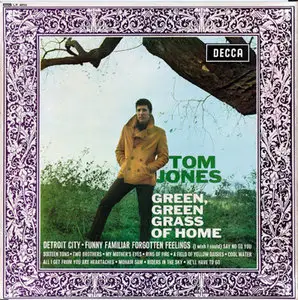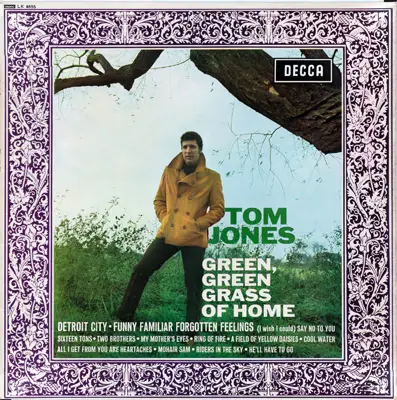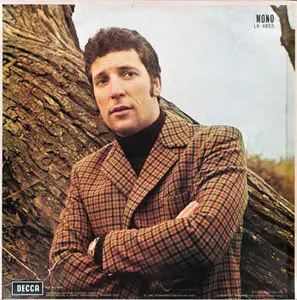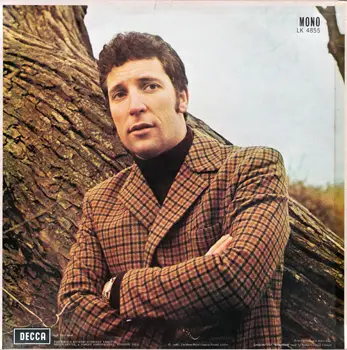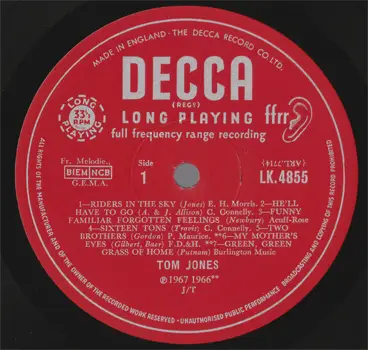Tom Jones - Green, Green Grass Of Home
FLAC | Artwork | 24Bit 96kHz: 483 MB | 16Bit 44.1kHz: 162 MB
Cat#: Decca LK 4855 | Country/Year: UK 1967 (Mono LP)
Genre: Pop | Hoster: Filesonic
MD5 [X] FFP [] CUE [] LOG [] INFO TEXT [X] ARTWORK [X]
webfind [] selfrip [X]
Info:
Tom Jones - Green, Green Grass Of Home
Label: Decca
Catalog#: LK 4855
Format: Vinyl, LP, Mono
Country: UK
Released: 1967
Genre: Rock
Style: Lounge, Pop Rock
Tracklist:
A1 Riders In The Sky
A2 He'll Have To Go
A3 Funny Familiar Forgotten Feelings
A4 Sixteen Tons
A5 Two Brothers
A6 My Mother's Eyes
A7 Green, Green Grass Of Home
B1 Ring Of Fire
B2 A Field Of Yellow Daisies
B3 (I Wish I Could) Say No To You
B4 All I Get From You Are Heartaches
B5 Mohair Sam
B6 Cool Water
B7 Detroit City
Discogs Url: http://www.discogs.com/Tom-Jones-Green-Green-Grass-Of-Home/release/1190643
Biography
by Stephen Thomas Erlewine
Tom Jones became one of the most popular vocalists to emerge from the British Invasion. Since the mid-'60s, Jones has sung nearly every form of popular music – pop, rock, show tunes, country, dance, and techno, he's sung it all. His actual style – a full-throated, robust baritone that had little regard for nuance and subtlety – never changed, he just sang over different backing tracks. On-stage, Jones played up his sexual appeal; it didn't matter whether he was in an unbuttoned shirt or a tuxedo, he always radiated a raw sexuality which earned him a large following of devoted female fans who frequently threw underwear on-stage. Jones' following never diminished over the decades; he was able to exploit trends, earning new fans while retaining his core following.
Born Thomas John Woodward, Jones began singing professionally in 1963, performing as Tommy Scott with the Senators, a Welsh beat group. In 1964, he recorded a handful of solo tracks with record producer Joe Meek and shopped them to various record companies to little success. Later in the year, Decca producer Peter Sullivan discovered Tommy Scott performing in a club and directed him to manager Phil Solomon. It was a short-lived partnership and the singer soon moved back to Wales, where he continued to sing in local clubs. At one of the shows, he gained the attention of former Viscounts singer Gordon Mills, who had become an artist manager. Mills signed Scott, renamed him Tom Jones, and helped him record his first single for Decca, "Chills and Fever," which was released in late 1964. "Chills and Fever" didn't chart but "It's Not Unusual," released in early 1965, became a number one hit in the U.K. and a Top Ten hit in the U.S. The heavily orchestrated, over-the-top pop arrangements perfectly meshed with Jones' swinging, sexy image, guaranteeing him press coverage, which translated into a series of hits, including "Once Upon a Time," "Little Lonely One," and "With These Hands." During 1965, Mills also secured a number of film themes for Jones to record, including the Top Ten hit "What's New Pussycat?" (June 1965) and "Thunderball" (December 1965).
Jones' popularity began to slip somewhat by the middle of 1966, causing Mills to redesign the singer's image into a more respectable, mature, tuxedoed crooner. Jones also began to sing material that appealed to a broad audience, like the country songs "Green, Green Grass of Home" and "Detroit City." The strategy worked, as he returned to the top of the charts in the U.K. and began hitting the Top 40 again in the U.S. For the remainder of the '60s, he scored a consistent string of hits in both Britain and America. At the end of the decade, Jones relocated to America, where he hosted the television variety program This Is Tom Jones. Running between 1969 and 1971, the show was a success and laid the groundwork for the singer's move to Las Vegas in the early '70s. Once he moved to Vegas, Jones began recording less, choosing to concentrate on his lucrative club performances. After Gordon Mills died in the late '70s, Jones' son, Mark Woodward, became the singer's manager. The change in management prompted Jones to begin recording again. This time, he concentrated on the country market, releasing a series of slick Nashville-styled country-pop albums in the early '80s that earned him a handful of hits.
Jones' next image makeover came in 1988, when he sang Prince's "Kiss" with the electronic dance outfit the Art of Noise. The single became a Top Ten hit in the U.K. and reached the American Top 40, which led to a successful concert tour and a part in a recording of Dylan Thomas' voice play, Under Milk Wood. The singer then returned to the club circuit, where he stayed for several years. In 1993, Jones performed at the Glastonbury Festival in England, where he won an enthusiastic response from the young crowd. Soon, he was on the comeback trail again, releasing the alternative dance-pop album The Lead and How to Swing It in the fall of 1994; the record was a moderate hit, gaining some play in dance clubs. Jones enjoyed an even bigger hit with 1999's Reload, which featured duets with an array of contemporaries and those he influenced. Three years later, he worked with Wyclef Jean to produce Mr. Jones, and 2004 brought another collaboration, Tom Jones and Jools Holland. In 2008, he released another commercial and critical success, 24 Hours, which featured Jones' classic sound backed by contemporary productions from Future Cut, Nellee Hooper, and Betty Wright. His 2010 release, Praise & Blame, went in a completely different direction, filled with American Songbook material from the likes of Bob Dylan, John Lee Hooker, and Billy Joe Shaver. allmusicguide
=Hardware=
LP>
Shure M97xE>
Dual CS 505-3>
Handcrafted low capacitance custom cables, teflon® insulated & silver-plated coaxial conductors>
Kenwood C1 Custom Revision I>
- Phono Stage input and RIAA equalisation capacitors replaced by Styroflex and Polypropylen types resp.
- Electrolytic capacitors not mounted by manufacturer onto the RIAA stage power Supply refitted (Philips NOS types)
- All electrolytic capacitors in signal chain replaced by foil capacitors
- All old JRC OpAmps replaced by Burr Brown (Phono Stage) and Analog Devices OpAmps resp.>
Handcrafted low capacitance custom cables, polyethylene insulated twinaxial conductors>
Audiotrak Prodigy 7.1 HiFi w/ AD712 OpAmps @ 24/96>
HDD
=Software=
Adobe Audition 3
ClickRepair
Trader´s Little Helper (FLAC)
+16Bit Version:
Izotope RX
Dither: MBIT+
Date of rip: 2011-03-22
Please keep the info sheet included if you share this!
Links:
[Filesonic/250MB]
24Bit/96kHz Version
http://www.filesonic.com/file/...-ToJo-GrGrGrOfHo-24B.part1.rar
http://www.filesonic.com/file/...-ToJo-GrGrGrOfHo-24B.part2.rar
16Bit/44.1kHz Version
http://www.filesonic.com/file/336794424/FHQA-ToJo-GrGrGrOfHo-16B.rar
If you have problems extracting the RAR files on your HD, please verify these checksums. If they do not match, redownload the not-matching part and try again.
(copy & paste to your editor and save as *.md5 in the folder where the RAR files are located)
16Bit
c6eb42d896dbc28ef48c97bce5902532 *FHQA-ToJo-GrGrGrOfHo-16B.rar
24Bit
4f2772b2d1cf177fc96211f130c5f3c3 *FHQA-ToJo-GrGrGrOfHo-24B.part1.rar
1bb74bf508cccdeefd15284761f323e7 *FHQA-ToJo-GrGrGrOfHo-24B.part2.rar
Password:
finest-hq-audio
Check my blog for other lossless uploads:
http://www.avaxhome.ws/blogs/luckburz


